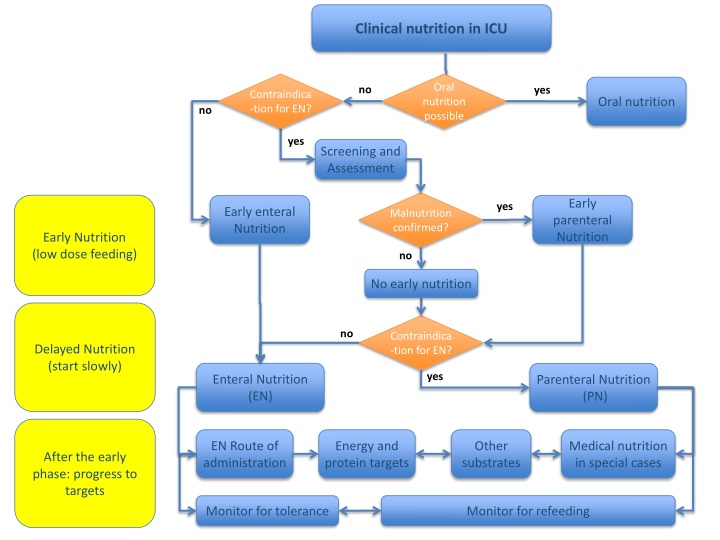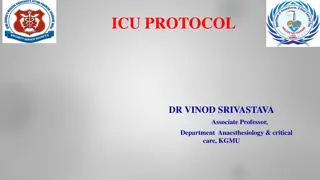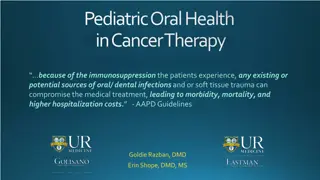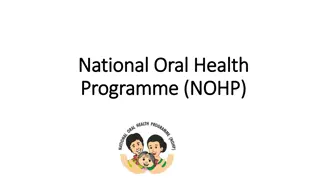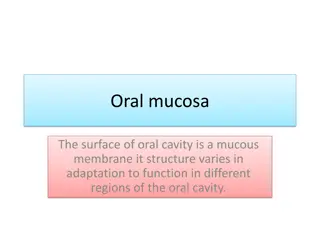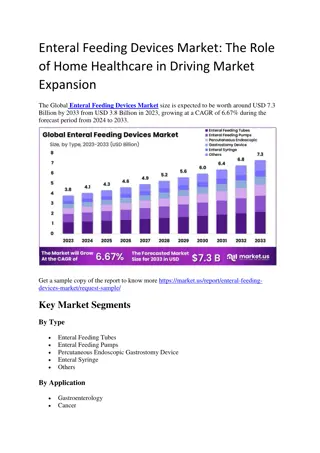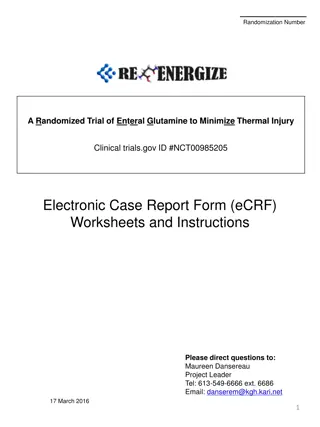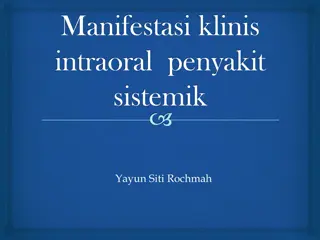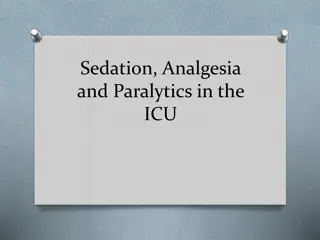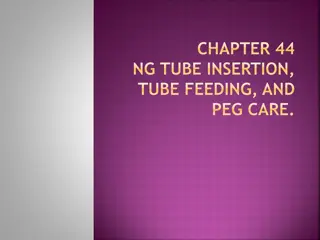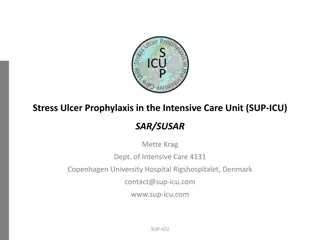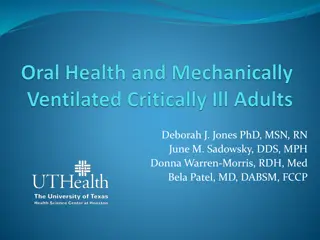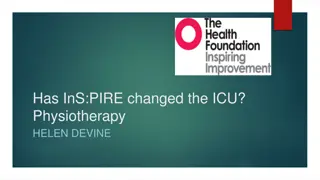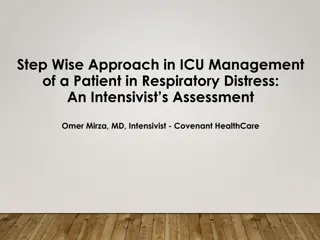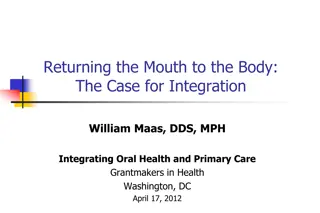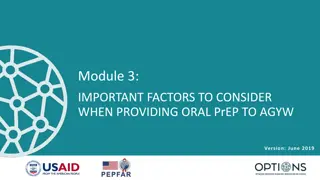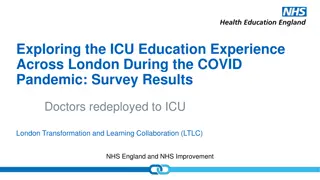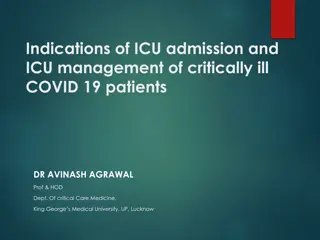Clinical Nutrition in ICU: Oral Nutrition and Early Enteral Nutrition
In the ICU, clinical nutrition plays a crucial role in managing critically ill patients to prevent malnutrition. This involves assessing the feasibility of oral nutrition, screening for malnutrition, and considering early enteral nutrition over parenteral nutrition when possible. Guidelines recommend initiating nutrition therapy within 48 hours for patients unable to eat orally, with a focus on avoiding overfeeding and adjusting feeding regimes based on patient tolerance. Special considerations apply to patients with specific medical conditions, and monitoring for refeeding syndrome is essential throughout the nutritional intervention.
Download Presentation

Please find below an Image/Link to download the presentation.
The content on the website is provided AS IS for your information and personal use only. It may not be sold, licensed, or shared on other websites without obtaining consent from the author.If you encounter any issues during the download, it is possible that the publisher has removed the file from their server.
You are allowed to download the files provided on this website for personal or commercial use, subject to the condition that they are used lawfully. All files are the property of their respective owners.
The content on the website is provided AS IS for your information and personal use only. It may not be sold, licensed, or shared on other websites without obtaining consent from the author.
E N D
Presentation Transcript
Clinical nutrition in ICU Oral nutrition possible no yes Contraindica -tion for EN? Oral nutrition no yes Screening and Assessment Early yes Early enteral Nutrition Malnutrition confirmed? parenteral Nutrition Early Nutrition (low dose feeding) no No early nutrition no Contraindica -tion for EN? Delayed Nutrition (start slowly) yes Enteral Nutrition (EN) Parenteral Nutrition (PN) EN Route of administration Energy and protein targets Other substrates Medical nutrition in special cases After the early phase: progress to targets Monitor for refeeding Monitor for tolerance
Clinical nutrition in ICU 2) Medical nutrition therapy shall be considered for all patients staying in the ICU, mainly for more than 48 h (R1, GPP, 100%) 1) Every critically ill patient staying for more than 48 h in the ICU should be considered at risk for malnutrition. (S1, 96%) Oral nutrition possible? yes Oral nutrition 4) A general clinical assessment should be performed to assess malnutrition in the ICU, until a specific tool has been validated. (R2, GPP, 100%) (at least partial oral nutrition) 3) Oral diet shall be preferred over EN or PN in critically ill patients who are able to eat. (R3, GPP, 100%) no no yes Screening and Assessment Contraindica tion for EN? 5) To avoid overfeeding, early full EN and PN shall not be used in critically ill patients but shall be prescribed within three to seven days. (R8, A, 100%) yes Early enteral nutrition Early parenteral nutrition Malnutrition confirmed? no No early nutrition Fig. 3 + 4
Early medical nutrition (EN / PN) Early enteral nutrition Early parenteral nutrition 6) If oral intake is not possible, early EN (within 48 hours) in critically ill adult patients should be performed/initiated rather than delaying EN (R4, B, 100%) 9) Early and progressive PN can be provided instead of no nutrition in case of contraindications for EN in severely malnourished patients. (R7, 0, 95%) 7) If oral intake is not possible, early EN (within 48 hours) shall be performed/initiated in critically ill adult patients rather than early PN (R5, A, 100%) 10) In patients who do not tolerate full dose EN during the first week in the ICU, the safety and benefits of initiating PN should be weighed on a case-by-case basis. (R20, GPP, 96%) 8) Early EN should be performed in patients receiving extracorporeal membrane oxygenation (ECMO) in patients with traumatic brain injury in patients with stroke (ischemic or hemorrhagic) in patients with spinal cord injury in patients with severe acute pancreatitis in patients after gastrointestinal surgery in patients after abdominal aortic surgery in patients with abdominal trauma when the continuity of the GI tract is confirmed/restored in patients receiving neuromuscular blocking agents in patients managed in prone position In patients with open abdomen regardless of the presence of bowel sounds unless bowel ischemia or obstruction is suspected in patients with diarrhea (R40, B, 96%)
Delayed medical nutrition (EN / PN) Parenteral Nutrition (PN) partial if possible Enteral Nutrition (EN) Contraindica tion for EN? yes no 17) In case of contraindications to oral and EN, PN should be implemented within three to seven days. (R6, B, 89%) 11) EN should be delayed if shock is uncontrolled and hemodynamic and tissue perfusion goals are not reached, whereas low dose EN can be started as soon as shock is controlled with fluids and vasopressors/inotropes, while remaining vigilant for signs of bowel ischemia; in case of uncontrolled life-threatening hypoxemia, hypercapnia or acidosis, whereas EN can be started in patients with stable hypoxemia, and compensated or permissive hypercapnia and acidosis; in patients suffering from active upper gastrointestinal bleeding, whereas EN can be started when the bleeding has stopped and no signs of re-bleeding are observed; in patients with overt bowel ischemia; in patients with high-output intestinal fistula if reliable feeding access distal to the fistula is not achievable; in patients with abdominal compartment syndrome; and if gastric aspirate volume is above 500 mL/6 h. (R38, B, 100%) 12) Low dose EN should be administered in patients receiving therapeutic hypothermia and increasing the dose after rewarming; in patients with intra- abdominal hypertension without abdominal compartment syndrome, whereas temporary reduction or discontinuation of EN should be considered when intra-abdominal pressure values further increase under EN; and in patients with acute liver failure when acute, immediately life-threatening metabolic derangements are controlled with or without liver support strategies, independent on grade of encephalopathy. (R39, B, 96%) 18) PN should not be started until all reasonable strategies to improve EN tolerance have been attempted. (R21, updated, GPP, 100%) EN Route of administration 13) In patients deemed to be at high risk for aspiration, postpyloric, mainly jejunal feeding can be performed. (R12, GPP, 95%) 14) Continuous rather than bolus EN should be used. (R9, B, 95%) 15) Gastric access should be used as standard approach to initiate EN. (R10, GPP, 100%) 16) In patients with gastric feeding in-tolerance not solved with prokinetic agents, postpyloric feeding should be used. (R11, B, 100%)
1 21) If calorimetry is not available, using VO2(oxygen consumption) from pulmonary arterial catheter or VCO2 (carbon dioxide production) derived from the ventilator will give a better evaluation on energy expenditure than predictive equations. (S2, 82%) Determination of energy needs Energy and protein targets 2 yes 19) In critically ill mechanically ventilated patients, EE should be determined by using indirect calorimetry. (R15, B, 95%) no yes V02/VCO2 available? Calorimetry available? no 20) If indirect calorimetry is used, isocaloric nutrition rather than hypocaloric nutrition can be progressively implemented after the early phase of acute illness. (R16, 0, 95%) 24) After day 3, caloric delivery can be increased up to 80 - 100% of measured energy expenditure . (R18, 0, 95%) 22) If predictive equations are used to estimate the energy need, hypocaloric nutrition (below 70% estimated needs) should be preferred over isocaloric nutrition for the first week of ICU stay. (R19, B, 95%) 23) Hypocaloric nutrition (not exceeding 70% of EE) should be administered in the early phase of acute illness. (R17, B, 100%) Protein intake and exercise 25) During critical illness, 1.3 g/kg protein equivalents per day can be delivered progressively. (R22, updated, 0, 92%) 26) Physical activity may improve the beneficial effects of nutritional therapy (S3, 86%)
Other substrates Glucose / Carbohydrates Glutamine (GLN) Fish oil (omega-3) Micronutrients 34) High doses of omega- 3-enriched EN formula should not be given by bolus administration. (R30, B, 91%) 38) To enable substrate metabolism, micronutrients (i.e. trace elements and vitamins) should be provided daily with PN. (R34, B, 100%) 27) The amount of glucose (PN) or carbohydrates (EN) administered to ICU patients should not exceed 5 mg/kg/min. (R23, GPP, 100%) 30) In patients with burns > 20% body surface area, additional enteral doses of GLN (0.3 - 0.5 g/kg/d) should be administered for 10 - 15 days as soon as EN is commenced. (R26, B, 95%)* 35) EN enriched with omega-3 FA within nutritional doses can be administered. (R31, 0, 95%) 31) In critically ill trauma, additional EN doses of GLN (0.2 - 0.3 g/kg/d) can be administered for the first five days with EN. In case of complicated wound healing it can be administered for a longer period of 10 15 days. (R27, 0, 91%) 39) Antioxidants as high- dose monotherapy or combination therapy should not be administered without proven deficiency. (R35, updated, A, 100%) Lipids 28) The administration of intravenous lipid emulsions should be generally a part of PN. 27) The administration of intravenous lipid emulsions should be generally a part of PN. (R24, GPP, 100%) (R24, GPP, 100%) 36) High doses omega-3 enriched enteral formulas should not be given on a routine basis. (R32, B, 90%) 32) In ICU patients except burn and trauma patients, additional enteral GLN should not be administered. (R28, B, 92%) 40) Vitamin D (25(OH)D) status can be determined in all patients considered at risk of vitamin D depletion or deficiency. (R36, updated, GPP, 100%) 33) In unstable and complex ICU patients, particularly in those suffering from liver and renal failure, parenteral GLN - dipeptide shall not be administered. (R29, A, 92%) 29) Intravenous lipid (including non-nutritional lipid sources) should not exceed 1.5 g lipids/kg/d and should be adapted to individual tolerance. (R25, GPP, 100%) 37) Parenteral lipid emulsions enriched with EPA + DHA (Fish oil dose 0.1-0.2 g/kg/d) can be provided in patients receiving PN. (R33, updated, 0, 100%) * recommendation to be revised in the near future
Medical nutrition in special cases The obese patient The trauma patient The non- intubated patient The surgical patient 44) In patients after abdominal or esophageal surgery, early EN can be preferred over delayed EN. (R45, 0, 96%) 49) Trauma patients should preferentially receive early EN instead early PN. (R50, B, 96%) 51) An iso-caloric high protein diet can be administered to obese patients, preferentially guided by indirect calorimetry measurements and urinary nitrogen losses. (R51, 0, 89%) 41) In non-intubated patients not reaching the energy target with an oral diet, oral nutritional supplements should be considered first and then EN. (R41, GPP, 96%) 45) In critically ill patients with surgical complications after abdominal or esophageal surgery and unable to eat orally, EN (rather than PN) should be preferred unless discontinuity or obstruction of GI tract, or abdominal compartment syndrome is present. (R46, GPP, 96%) 52) In obese patients, energy intake should be guided by indirect calorimetry. Protein delivery should be guided by urinary nitrogen losses or lean body mass determination (using computerized tomography or other tools). If indirect calorimetry is not available, energy intake can be based on adjusted body weight . If urinary nitrogen losses or lean body mass determination are not available, protein intake can be 1.3 g/kg adjusted body weight /d. (R52, GPP, 89%) 42) In non-intubated patients with dysphagia, texture-adapted food can be considered. If swallowing is proven unsafe, EN should be administered. (R42, GPP, 94%) The septic patient 46) In the case of an unrepaired anasto-motic leak, internal or external fistula, a feeding access distal to the defect should be aimed for to administer EN. (R47, GPP, 96%) 50) Early and progressive EN should be used in septic patients after hemodynamic stabilization. If contraindicated, EN should be replaced or supplemented by progressive PN. (R44, GPP, 94%) 43) In non-intubated patients with dysphagia and a very high aspiration risk, postpyloric EN or, if not possible, temporary PN during swallowing training with removed nasoenteral tube can be performed. (R43, GPP, 92%) 47) In the case of an unrepaired anastomotic leak, internal or external fistula, or if distal feeding access is not achieved, EN should be withheld and PN may be commenced. (R48, GPP, 100%) 48) In case of high output stoma or fistula, the appropriateness of chyme reinfusion or enteroclysis should be evaluated and performed if adequate. (R49, GPP, 100%)
Monitoring of medical nutrition Monitor for tolerance, overfeeding and unterfeeding Monitor for refeeding Refeeding hypophosphatemia EN feeding intolerance Glucose and insulin Electrolytes 57) Electrolytes (potassium, magnesium, phosphate) should be measured at least once daily for the first week. (R55, A, 93%) 53) Blood glucose should be measured initially (after ICU admission or after artificial nutrition initiation) and at least every four hours, for the first two days in general. (R53, GPP, 93%) 58) In patients with refeeding hypophosphatemia (<0.65 mmol/L or a drop of >0.16 mmol/L), electrolytes should be measured 2 - 3 times a days and supplemented if needed. (R56, GPP, 92%) 55) In critically ill patients with gastric feeding intolerance, intravenous erythromycin should be used as a first line prokinetic therapy. (R13, B, 100%) 56) Alternatively, intravenous metoclopramide or a combination of meto- clopramide and erythromycin can be used as a prokinetic therapy. (R14, 0, 100%) 54) Insulin shall be administered, when glucose levels exceed 10 mmol/L (R54, A, 93%) 59) In patients with refeeding hypophosphatemia energy supply should be restricted for 48 h and then gradually increased. (R57, B, 100%)
